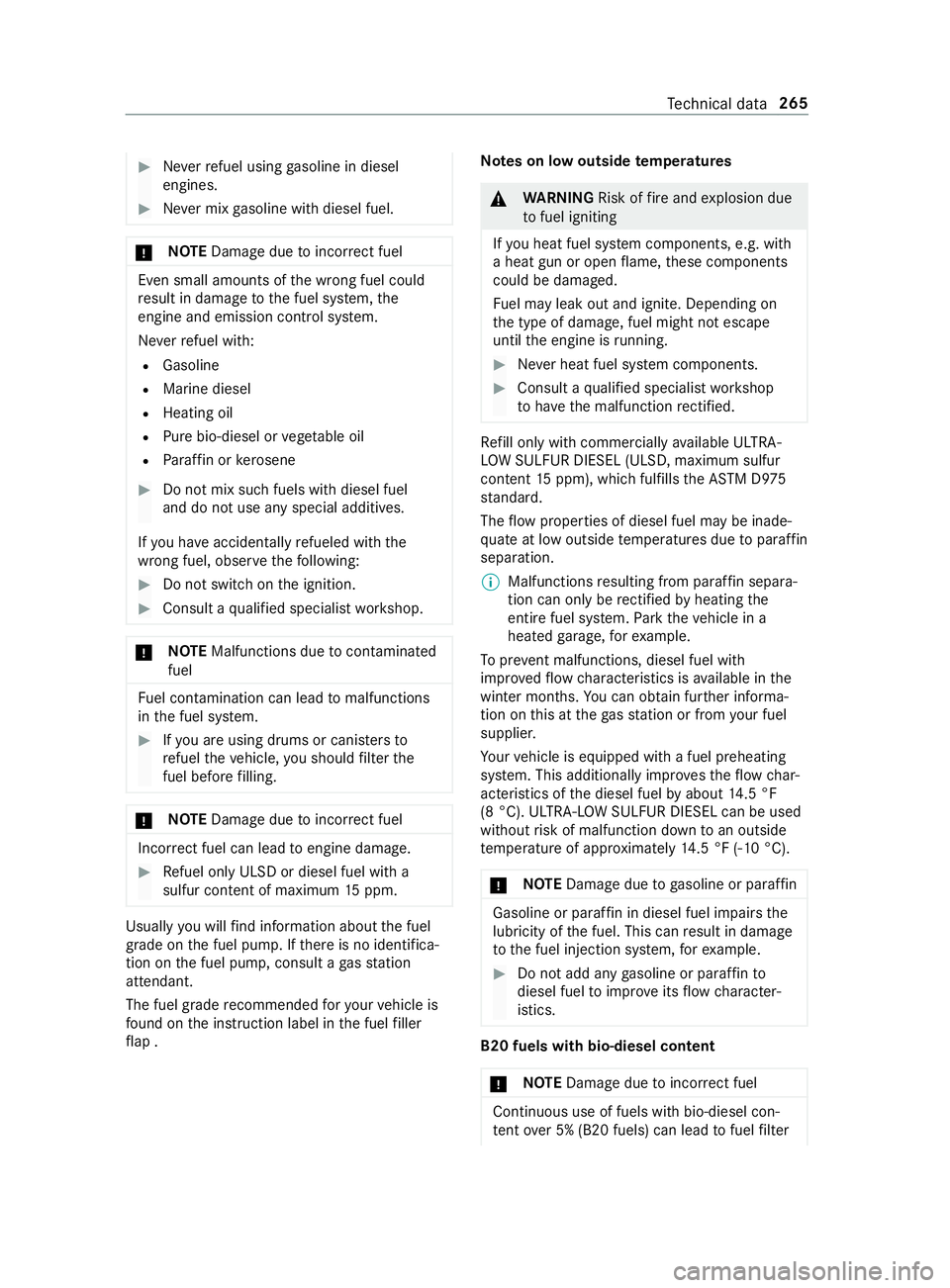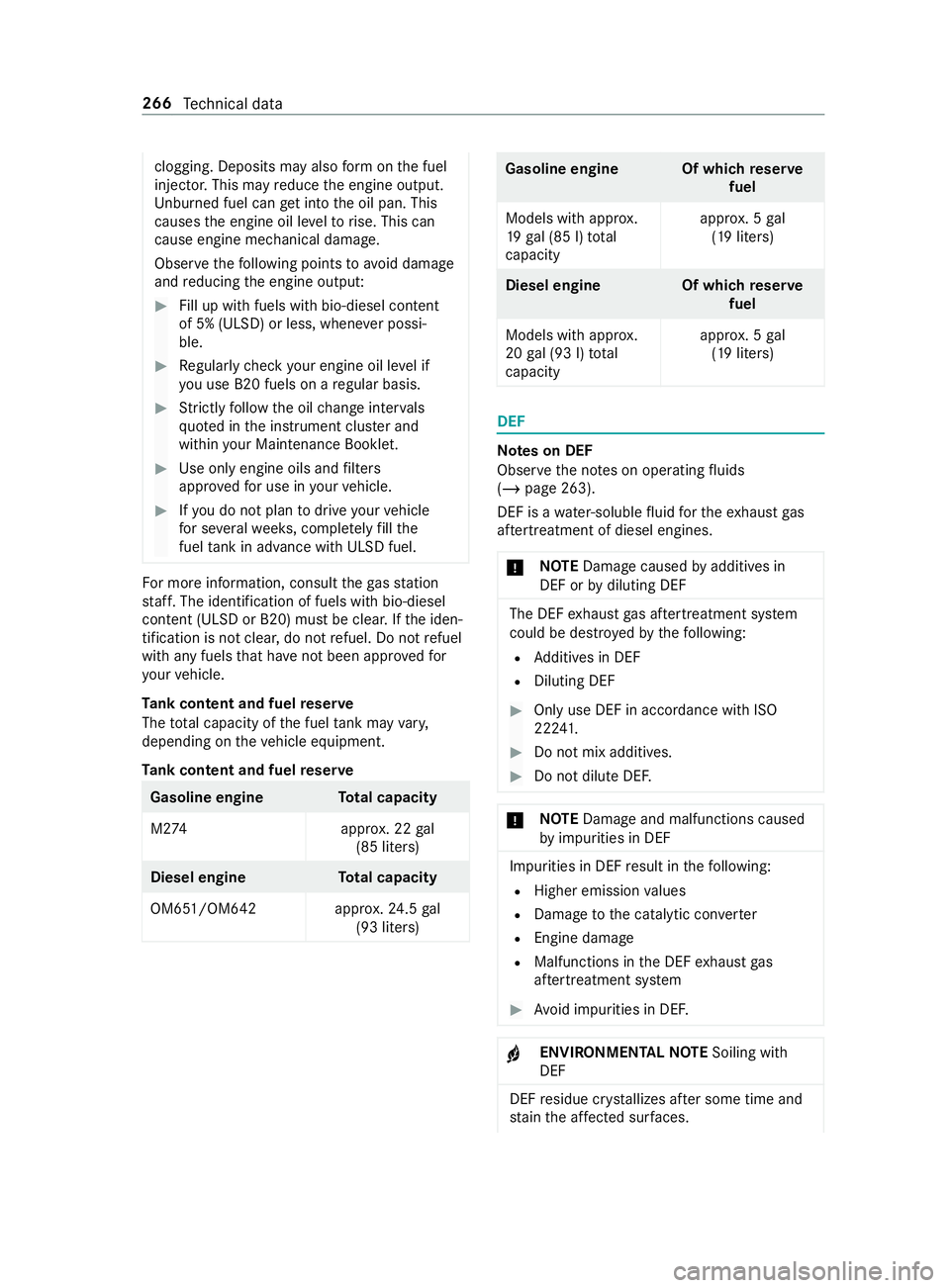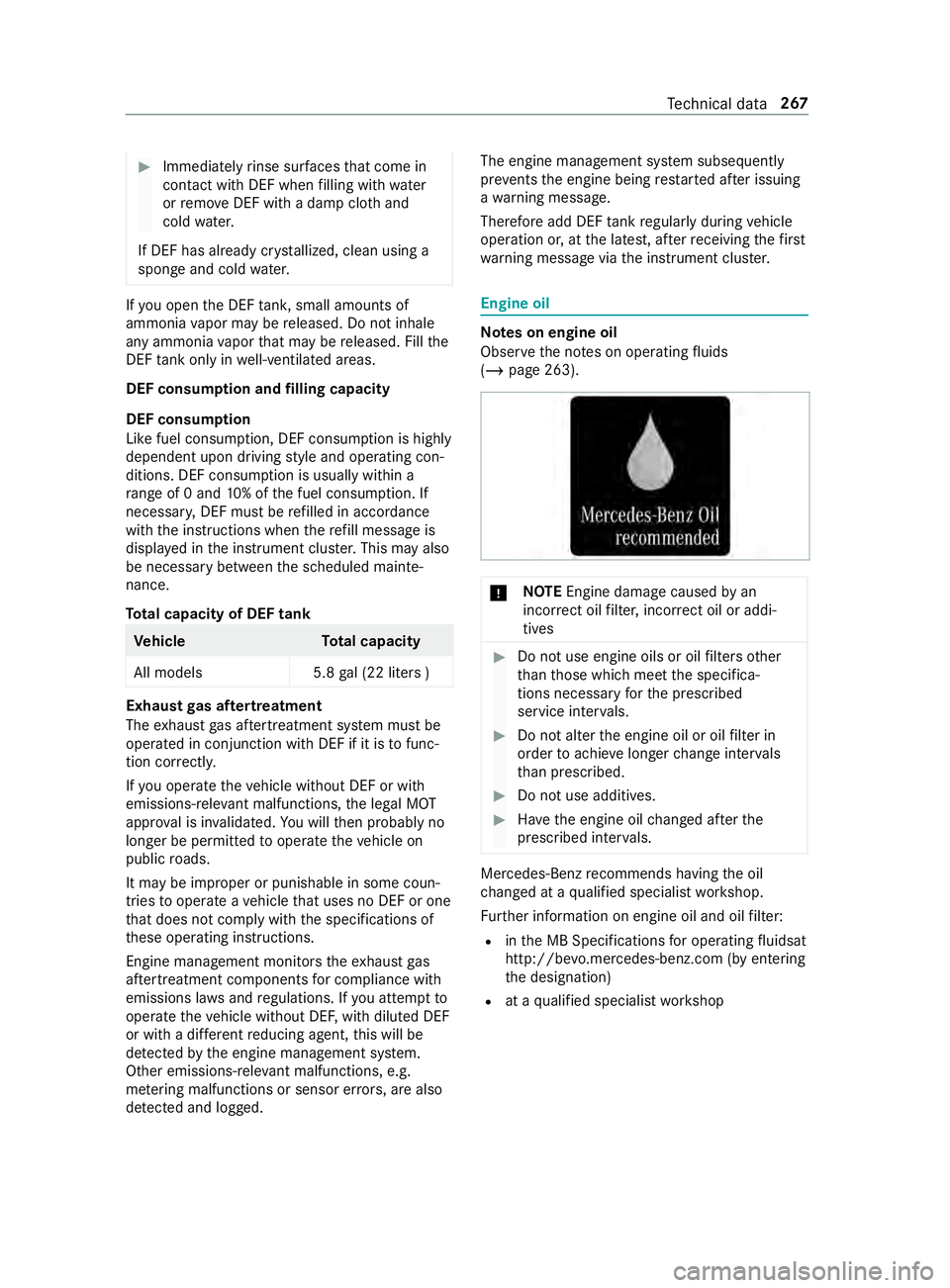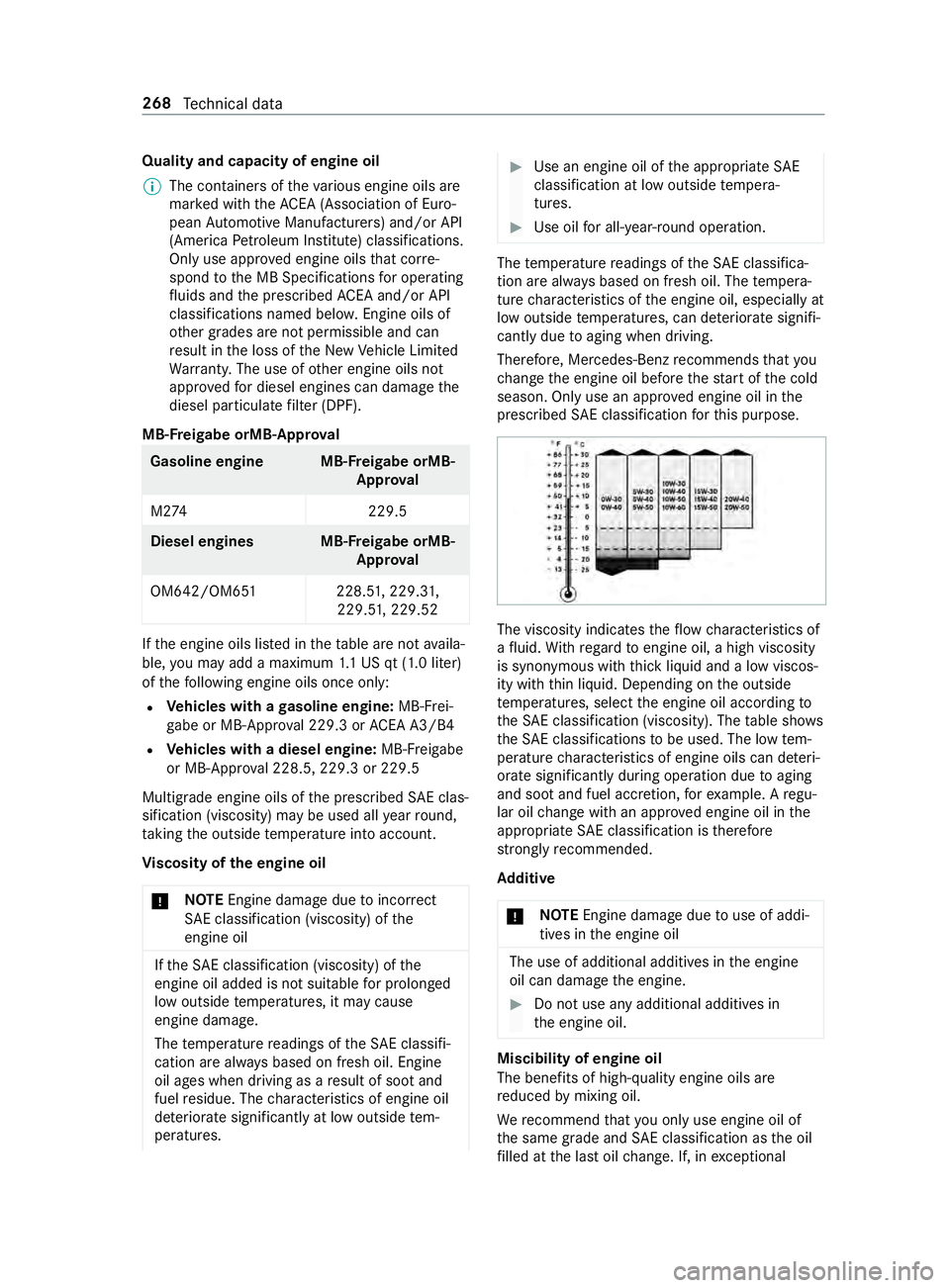oil additives MERCEDES-BENZ SPRINTER 2019 MY19 with 7” screen
[x] Cancel search | Manufacturer: MERCEDES-BENZ, Model Year: 2019, Model line: SPRINTER, Model: MERCEDES-BENZ SPRINTER 2019Pages: 354, PDF Size: 6.15 MB
Page 289 of 354

#
Neverre fuel using gasoline in diesel
engines. #
Never mix gasoline with diesel fuel. *
NO
TEDama gedue toincor rect fuel Even small amounts of
the wrong fuel could
re sult in damage tothe fuel sy stem, the
engine and emission cont rol sy stem.
Ne verre fuel with:
R Gasoline
R Marine diesel
R Heating oil
R Pure bio-diesel or vege tab le oil
R Paraffin or kerosene #
Do not mix such fuels with diesel fuel
and do not use any special additives.
If yo u ha veaccidentally refueled with the
wrong fuel, obser vethefo llowing: #
Do not switch on the ignition. #
Consult a qualified specialist workshop. *
NO
TEMalfunctions due tocontaminated
fuel Fu
el contamination can lead tomalfunctions
in the fuel sy stem. #
Ifyo u are using drums or canis ters to
re fuel theve hicle, you should filter the
fuel before filling. *
NO
TEDama gedue toincor rect fuel Incor
rect fuel can lead toengine damage. #
Refuel only ULSD or diesel fuel with a
sulfur content of maximum 15ppm. Usually
you will find information about the fuel
grade on the fuel pump. If there is no identifica‐
tion on the fuel pump, consult a gasst ation
attendant.
The fuel grade recommended foryo ur vehicle is
fo und on the instruction label in the fuel filler
fl ap . Note
s on low outside temperatures &
WARNING Risk offire and explosion due
to fuel igniting
If yo u heat fuel sy stem components, e.g. with
a heat gun or open flame, these components
could be damaged.
Fu el may leak out and ignite. Depending on
th e type of damage, fuel might not escape
until the engine is running. #
Never heat fuel sy stem components. #
Consult a qualified specialist workshop
to have the malfunction rectified. Re
fill only with commercially available ULTRA-
LO W SULFUR DIESEL (ULSD, maximum sulfur
content 15ppm), which fulfills the ASTM D9 75
st andard.
The flow properties of diesel fuel may be inade‐
qu ate at low outside temp eratures due toparaf fin
separation.
% Malfunctions
resulting from paraf fin separa‐
tion can only be rectified byheating the
entire fuel sy stem. Park theve hicle in a
heated garage ,fo rex ample.
To prev ent malfunctions, diesel fuel with
impr oved flow ch aracteristics is available in the
winter mon ths. Yo u can obtain fur ther informa‐
tion on this at thega sst ation or from your fuel
supplier.
Yo ur vehicle is equipped with a fuel preheating
sy stem. This additionally impr ovesth eflow char‐
acteristics of the diesel fuel byabout 14.5 °F
(8 °C). ULTR A-LO W SULFUR DIESEL can be used
without risk of malfunction down toan outside
te mp erature of appr oximately 14.5 °F (-10 °C).
* NO
TEDama gedue togasoline or paraf fin Gasoline or paraf
fin in diesel fuel impairs the
lubricity of the fuel. This can result in damage
to the fuel injection sy stem, forex ample. #
Do not add any gasoline or paraf fin to
diesel fuel toimpr oveitsflow character‐
istics. B20 fuels with bio-diesel content
* NO
TEDama gedue toincor rect fuel Continuous use of fuels wi
thbio-diesel con‐
te nt ove r 5% (B20 fuels) can lead tofuel filter Te
ch nical da ta265
Page 290 of 354

clogging. Deposits may also
form onthe fuel
injec tor.This may reduce the engine output.
Unburned fuel can get into the oil pan. This
causes the engine oil le velto rise. This can
cause engine mechanical damage.
Obser vethefo llowing points to avoid damage
and reducing the engine output: #
Fill up with fuels with bio-diesel content
of 5% (ULSD) or less, whene ver possi‐
ble. #
Regular lych eck your engine oil le vel if
yo u use B20 fuels on a regular basis. #
Strictly follow the oil change inter vals
qu oted in the instrument clus ter and
within your Main tenance Bookl et. #
Use only engine oils and filters
appr ovedfo r use in your vehicle. #
Ifyo u do not plan todrive your vehicle
fo r se veralwe eks, comple tely fill the
fuel tank in ad vance wi thULSD fuel. Fo
r more information, consult thega sst ation
st aff. The identification of fuels with bio-diesel
con tent (ULSD or B20) must be clear. If the iden‐
tification is not clear, do not refuel. Do not refuel
with any fuels that ha venot been appr ovedfor
yo ur vehicle.
Ta nk content and fuel reser ve
The total capacity of the fuel tank may vary,
depending on theve hicle equipment.
Ta nk content and fuel reser ve Gasoline engine
Total capacity
M2 74 approx. 22 gal
(85 liters) Diesel engine
Total capacity
OM6 51/OM642 appr ox.24 .5 gal
(93 liters) Gasoline engine Of which
reser ve
fuel
Models with appr ox.
19 gal (85 l) total
capacity appr
ox. 5 gal
(19 liters) Diesel engine Of which
reser ve
fuel
Models with appr ox.
20 gal (93 l) total
capacity appr
ox. 5 gal
(19 liters) DEF
Note
s on DEF
Obser vethe no tes on operating fluids
(/ page 263).
DEF is a water-soluble fluid forth eex haust gas
af te rtre atment of diesel engines.
* NO
TEDama gecaused byadditives in
DEF or bydiluting DEF The DEF
exhaust gas af tertre atment sy stem
could be destr oyed bythefo llowing:
R Additives in DEF
R Diluting DEF #
Only use DEF in accordance with ISO
222 41 . #
Do not mix additives. #
Do not dilu teDEF. *
NO
TEDama geand malfunctions caused
by impurities in DEF Impurities in DEF
result in thefo llowing:
R Higher emission values
R Damage tothe catalytic con verter
R Engine damage
R Malfunctions in the DEF exhaust gas
af te rtre atment sy stem #
Avoid impurities in DEF. +
ENVIRONMENTAL
NOTESoiling wi th
DEF DEF
residue cr ystallizes af ter some time and
st ain the af fected sur faces. 266
Tech nical da ta
Page 291 of 354

#
Immedia tely rinse su rfaces that come in
con tact wi thDEF when filling with water
or remo veDEF wi tha damp clo thand
cold water.
If DEF has already cr ystallized, clean using a
spon geand cold water. If
yo u open the DEF tank, small amounts of
ammonia vapor may be released. Do not inhale
any ammonia vapor that may be released. Fill the
DEF tank only in well-ventilated areas.
DEF consum ption and filling capacity
DEF consum ption
Like fuel consum ption, DEF consum ption is highly
dependent upon driving style and operating con‐
ditions. DEF consum ption is usually within a
ra nge of 0 and 10% of the fuel consum ption. If
necessar y,DEF mu stbe refilled in acco rdance
with the instructions when there fill message is
displa yed in the instrument clus ter.This may also
be necessary between the scheduled mainte‐
nance.
To tal capacity of DEF tank Ve
hicl eT otal capacity
All model s5 .8gal (22 liters ) Exhau
stgas af tertre atment
The exhaust gas af tertre atment sy stem must be
operated in conjunction with DEF if it is tofunc‐
tion cor rectl y.
If yo u operate theve hicle without DEF or with
emissions-rele vant malfunctions, the legal MOT
appr oval is in validated. You will then probably no
longer be permitted tooperate theve hicle on
public roads.
It may be improper or punishable in some coun‐
tries tooperate a vehicle that uses no DEF or one
th at does not comply with the specifications of
th ese operating instructions.
Engine management monitors theex haust gas
af te rtre atment components for compliance with
emissions la wsand regulations. If you attem ptto
operate theve hicle without DEF, with diluted DEF
or with a dif fere nt reducing agent, this will be
de tected bythe engine management sy stem.
Other emissions- releva nt malfunctions, e.g.
me tering malfunctions or sensor er rors, are also
de tected and log ged. The engine management sy
stem subsequently
pr eve nts the engine being restar ted af ter issuing
a wa rning message.
Therefore add DEF tank regular lyduring vehicle
operation or, at the latest, af terre ceiving thefirst
wa rning message via the instrument clus ter. Engine oil
Note
s on engine oil
Obser vethe no tes on operating fluids
(/ page 263). *
NO
TEEngine damage caused byan
incor rect oil filter, incor rect oil or addi‐
tives #
Do not use engine oils or oil filters other
th an those which meet the specifica‐
tions necessary forth e prescribed
service inter vals. #
Do not alter the engine oil or oil filter in
order toachie velonger change inter vals
th an presc ribed. #
Do not use additives. #
Have the engine oil changed af terthe
prescribed inter vals. Mercedes-Benz
recommends having the oil
ch anged at a qualified specialist workshop.
Fu rther information on engine oil and oil filter:
R inthe MB Specifications for operating fluidsat
http://be vo.mercedes-benz.com (by entering
th e designation)
R at a qualified specialist workshop Te
ch nical da ta267
Page 292 of 354

Quality and capacity of engine oil
%
The containers of
theva rious engine oils are
mar ked with theAC EA (Association of Euro‐
pean Automotive Manufacturers) and/or API
(America Petroleum Institu te) classifications.
Only use appr oved engine oils that cor re‐
spond tothe MB Specifications for operating
fl uids and the prescribed ACEA and/or API
classi fications named bel ow. Engine oils of
ot her grades are not permissible and can
re sult in the loss of the New Vehicle Limited
Wa rrant y.The use of other engine oils not
appr ovedfo r diesel engines can dama gethe
diesel particulate filter (DPF).
MB- Freigabe orMB-App roval Gasoline engine MB-F
reigabe orMB-
Appr oval
M2 74 229.5Diesel engine
sMB-Freigabe orMB-
Appr oval
OM642/OM65 1228.51,229.3 1,
229.5 1,229.52 If
th e engine oils lis ted in theta ble are not availa‐
ble, you may add a maximum 1.1 US qt (1.0 liter)
of thefo llowing engine oils once only:
R Vehicles with a gasoline engine: MB-Frei‐
ga be or MB-Appr oval 229.3 or ACEA A3/B4
R Vehicles with a diesel engine: MB-Freigabe
or MB-Appr oval 228.5, 229.3 or 229.5
Multig rade engine oils of the prescribed SAE clas‐
si fication (viscosity) may be used all year round,
ta king the outside temp erature into account.
Vi scosity of the engine oil
* NO
TEEngine damage due toincor rect
SA E classi fication (viscosity) of the
engine oil If
th eSA E classi fication (viscosity) of the
engine oil added is not suitable for prolonged
low outside temp eratures, it may cause
engine damage.
The temp erature readings of theSA E classi fi‐
cation are al ways based on fresh oil. Engine
oil ages when driving as a result of soot and
fuel residue. The characteristics of engine oil
de teriorate significantly at low outside tem‐
peratures. #
Use an engine oil of the appropriate SAE
classi fication at low outside temp era‐
tures. #
Use oil for all-year-round operation. The
temp erature readings of theSA E classi fica‐
tion are al ways based on fresh oil. The temp era‐
ture characteristics of the engine oil, especially at
low outside temp eratures, can de teriorate signifi‐
cantly due toaging when driving.
Therefore, Mercedes-Benz recommends that you
ch ange the engine oil before thest art of the cold
season. Only use an appr oved engine oil in the
prescribed SAE classi fication forth is purpose. The viscosity indicates
theflow characteristics of
a fluid. With rega rd toengine oil, a high viscosity
is synonymous with thick liquid and a low viscos‐
ity with thin liquid. Depending on the outside
te mp eratures, select the engine oil according to
th eSA E classi fication (viscosity). The table sho ws
th eSA E classi fications tobe used. The low tem‐
perature characteristics of engine oils can de teri‐
orate significantly during operation due toaging
and soot and fuel acc retion, forex ample. A regu‐
lar oil change with an appr oved engine oil in the
appropriate SAE classi fication is therefore
stro ngly recommended.
Ad ditive
* NO
TEEngine damage due touse of addi‐
tives in the engine oil The use of additional additives in
the engine
oil can damage the engine. #
Do not use any additional additives in
the engine oil. Miscibility of engine oil
The benefits of high-quality engine oils are
re
duced bymixing oil.
We recommend that you on lyuse engine oil of
th e same grade and SAE classi fication as the oil
fi lled at the last oil change. If, in exceptional 268
Tech nical da ta